Mark Sisson's Blog, page 233
February 6, 2016
Primal Furikake
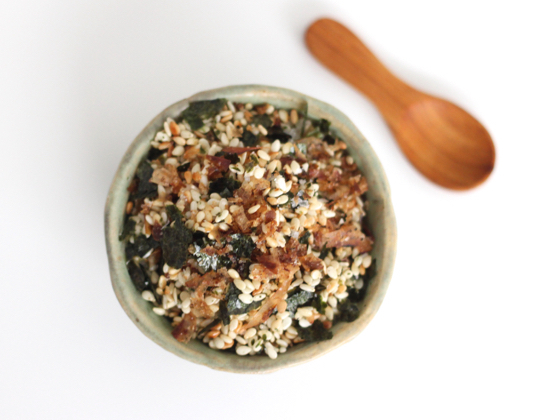 Furikake is a Japanese seasoning made from dried fish (bonito), sesame seeds, dried seaweed, salt, sugar, and often msg. A Primal version is easy to make–simply drop the sugar and msg–and you have a versatile seasoning for just about everything.
Furikake is a Japanese seasoning made from dried fish (bonito), sesame seeds, dried seaweed, salt, sugar, and often msg. A Primal version is easy to make–simply drop the sugar and msg–and you have a versatile seasoning for just about everything.
The ratio of ingredients can be tailored to your own taste, so simply use this furikake recipe as a guide. This particular recipe adds plenty of nori, since you can’t go wrong with a lot of nori.
Lightly toasted sesame seeds add crunch and the bonito flakes add an irreplaceable salty, umami flavor. Most grocery stores these days sell bonito flakes, or it can be ordered online. Bonito is air-dried, aged, and shaved tuna.
If you really miss the sweet flavor of sugar in furikake to contrast with all the saltiness, then add a little bit of unsweetened, toasted coconut flakes to the mix. You won’t be disappointed.
Keep a jar of furikake on your counter and you’ll find endless uses for it. Sprinkle it over cooked vegetables, seafood and red meat. Garnish cauliflower rice with furikake for an Asian flavor. Add furikake to eggs, sprinkle it over salad…it’s an addictive seasoning that can quickly add a lot of flavor to even the simplest of meals.
Servings: 3/4 cup furikake
Time in the Kitchen: 10 minutes
Ingredients:
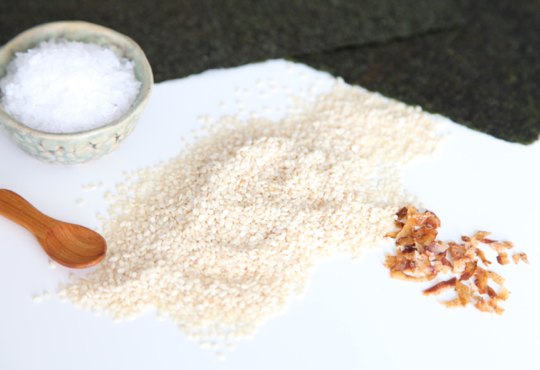
1/2 cup sesame seeds (75 g)
4 sheets toasted nori
1 tablespoon bonito flakes (15 ml)
1/2 teaspoon sea salt (2.5 ml)
Instructions:
In a dry skillet over medium heat, lightly toast the sesame seeds. Keep an eye on them–the seeds won’t seem to toast at all for several minutes, then suddenly they’ll go from raw to burnt very quickly.
Use scissors to cut the nori into small strips, or put all 4 nori sheets in the food processor at the same time. Process until the nori is in small, feathery pieces.
Combine the sesame seeds, nori, bonito flakes and sea salt. Store in a sealed jar.
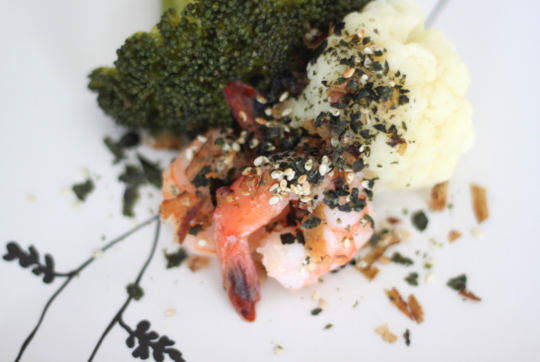
Not Sure What to Eat? Get the Primal Blueprint Meal Plan for Shopping Lists and Recipes Delivered Directly to Your Inbox Each Week. Now Available as an App!
February 5, 2016
Feeling 100 Times Better Than Ever Before
It’s Friday, everyone! And that means another Primal Blueprint Real Life Story from a Mark’s Daily Apple reader. If you have your own success story and would like to share it with me and the Mark’s Daily Apple community please contact me here. I’ll continue to publish these each Friday as long as they keep coming in. Thank you for reading!
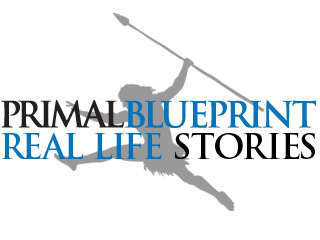 The first time I heard about Mark’s Daily Apple was the summer before I started my freshman year of college. My grandma loves health and had been watching the Diabetes Summit. She told two of my sisters, Kristen and Hannah, about Mark. They had fallen in love with all things Primal and when they told me about their new discovery, I completely dismissed it. I didn’t want to hear about it or even believe it because I was living in the complete opposite way. I wouldn’t touch a vegetable if you paid me and bread was my main food source. Then, I went to college and had a wake-up call.
The first time I heard about Mark’s Daily Apple was the summer before I started my freshman year of college. My grandma loves health and had been watching the Diabetes Summit. She told two of my sisters, Kristen and Hannah, about Mark. They had fallen in love with all things Primal and when they told me about their new discovery, I completely dismissed it. I didn’t want to hear about it or even believe it because I was living in the complete opposite way. I wouldn’t touch a vegetable if you paid me and bread was my main food source. Then, I went to college and had a wake-up call.
In college, I realized that I needed to change my diet. I was living off of sandwiches and fried foods at every meal. I wasn’t putting good fuel into my body and for the first time I actually wanted to change. I was now at a point in my life where I had some freedom and was responsible for myself. I no longer had my family to watch over my every move. With this new freedom, I wanted to make sure I took responsibility for all aspects of my life.
I called my sisters and asked them for the name of the person they were always talking about, and they directed me to Mark’s Daily Apple. I read many of the posts and wanted to know more about this lifestyle. I ordered The Primal Blueprint and had a very easy transition to eating healthy. Instead of sandwiches, I started eating lots of eggs, salads, and meat. For snacks, I ate trail mix consisting of almonds, pecans, dried cherries, coconut or apples, and almond butter. I didn’t miss the bread I had survived on for years or even have a tough time eating vegetables because I was now educated. I knew how much good I was doing for my body by cutting out the crap and fueling my body with delicious and nutritious foods. My body was also grateful for the change. I felt so much happier and healthier. I’m not sure if it was mental or not, but I truly felt 100 times better.
The very first week I was home from school for summer break, I decided to try out CrossFit. I learned from The Primal Blueprint how good functional training is, so I thought I would give it a try. I was hesitant at first but after my first WOD, I fell in love with it. Before finding CrossFit, I had been following conventional wisdom and had been focusing on one group of muscles to target each workout, instead of working my whole body. When I would work out, I wouldn’t even sweat and I didn’t have any fun. Now, I sweat profusely and I love every second of it! I actually look forward to working out and would recommend CrossFit to everyone.
 The transition from my unhealthy lifestyle to a primal lifestyle was so smooth because I had a strong support group: my family. It was easy to change because they were already practicing this healthy lifestyle. My family is all on board the primal train, which makes this lifestyle effortless. When I am home, my mom cooks the most healthy and delicious meals. She prepares all of these meals using fresh, organic ingredients. During the summer, we even get to grow our own vegetables from the garden my dad takes care of. Every day, we get to eat fresh salads with dressing my mom makes with herbs from our garden. It is hard to miss the junk food when you are eating foods that your taste buds and your body are thankful for.
The transition from my unhealthy lifestyle to a primal lifestyle was so smooth because I had a strong support group: my family. It was easy to change because they were already practicing this healthy lifestyle. My family is all on board the primal train, which makes this lifestyle effortless. When I am home, my mom cooks the most healthy and delicious meals. She prepares all of these meals using fresh, organic ingredients. During the summer, we even get to grow our own vegetables from the garden my dad takes care of. Every day, we get to eat fresh salads with dressing my mom makes with herbs from our garden. It is hard to miss the junk food when you are eating foods that your taste buds and your body are thankful for.
If you are struggling in making the transition to the primal lifestyle, I would recommend finding others that are also or have already made the transition to this type of lifestyle. My family keeps each other motivated by talking about health and sending each other articles we find on the topic. We look out for each other and keep each other in line and make health a family endeavor. If you have someone to join you on your health journey, you will be much more successful and happy.


February 4, 2016
Should You Favor Time or Money?
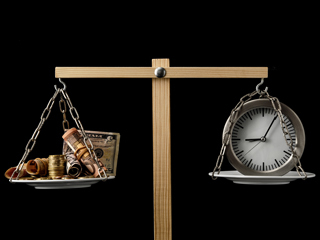 Time and money—the sources of endless hand-wringing in modern society. No one ever seems to have enough, including the people we think probably do. Instead of struggling with primeval conditions of scarcity, many of us are encumbered with the so-called “first-world problems” of modern day. For most of us, there’s a whole range of choices and flexibility that Grok never had. That said, when we bring a Primal perspective to the fore, just what is a healthy and productive relationship to time and money? And how much of each do we need to be happy?
Time and money—the sources of endless hand-wringing in modern society. No one ever seems to have enough, including the people we think probably do. Instead of struggling with primeval conditions of scarcity, many of us are encumbered with the so-called “first-world problems” of modern day. For most of us, there’s a whole range of choices and flexibility that Grok never had. That said, when we bring a Primal perspective to the fore, just what is a healthy and productive relationship to time and money? And how much of each do we need to be happy?
The fact is, our primal ancestors operated with a very different economy than the capitalist system many of us live and work within today. Social and cultural organization in Grok’s day, while far from “brutish,” was still unsophisticated with none of the luxuries or stressors that accompany advanced
economic structures. Grok and his kin still certainly needed and wanted things. It shouldn’t be much of a surprise that even our Primal ancestors were attracted to form as well as function. (Evidence of shells and beads used for fashion date back to over 80,000 years ago.)
But no doubts about it, our primal ancestors lived in a world of relative material scarcity when compared to ours today. Their innate interest for the new and shiny, an adaptive characteristic that encouraged creativity and favored innovation, was naturally capped by the dearth of resources—or the work it took to produce items from their raw forms. As a result, Grok and his people had all the instinct for invention and collection of “things” but with a limited variety and quantity of actual possessions.
Today we obviously live in a very different scenario. We not only retain the natural inclination toward the new and novel, but have the ability to get it (or at least a lot of it). And at times, we get too much of it. This begs the question: how do we reconcile our primal desires with the modern infinitude of opportunity to indulge them? Call it the burden of choice if you will.
In a global economy where a few clicks can hunt down and ship just about anything we could ever dream up, what’s tempering our innate desire for accumulation today isn’t scarcity of options—it’s money and time.
Most of us have a limited amount of money, and we give up our time in order to earn it. In short, we “spend” our time to be able to “spend” money on the things we need or want. Less time working means less money to spend. But it also means more time to enjoy life.
To put it bluntly, we each are in a position (albeit some more comfortably and flexibly than others) to decide how much life we’re going to give up in the pursuit of possessions.
Yes, most of what the majority of us earn goes toward shelter, food, basic utilities, health related costs, and savings for future security. Even within that narrow band of essentials, however, many of us are still working with quite a free range of possibility. Will we live in a place where housing expenses run high, or will we move somewhere with a lower cost of living? How large of a house do we need to live in—and pay to heat, cool, furnish, repair, etc.? What will we pay to make it look the way we want it to?
And then there are those things we may not call necessities but unconsciously accept as default purchases. Things like smart phones or cable T.V., for example. Or even larger cars, snowblowers, lawn equipment, and the like. Our consumption is much more subjective than most of us would automatically assume.
Of course, many of us also bring values to our purchases that go beyond the personal time-money equation. We opt to pay more to support local businesses or “fair trade” exchange, or to buy from companies that institute certain environmental or humane production practices. We’re willing to work harder and longer to buy something that we feel makes a positive impact on our greater world.
And that doesn’t even crack open the influence of our other preferences—whether in the taste, color, material, brand, store, etc. for what we purchase.
Given this complicated picture, how do we decide when we have enough money—when we’ve reached that earning sweet spot where spending any additional time in pursuit of more things just doesn’t offer appreciable added good to our lives? How do we divvy up our life between time earning money to keep or acquire things and time enjoying family, friends, hobbies, health and other joys of life?
In short, how do we want to balance living with making a living?
It’s important to take a minute to pay attention to what comes up when you ask yourself that question. What reflections, justifications, resistance, hopes, resentments, gratitude, regrets, and visions does that question evoke?
Maybe we’ve felt overwhelmed by our mortgages for years or feel pressured by our current lifestyles or financial obligations. Perhaps we resent the hours we put in or the commute we do every day to maintain our current job. Maybe we’re celebrating some good choices we made (either recently or long in the past) that have allowed us to enjoy life more on our own terms. Maybe we regret certain decisions and wonder how to get back to a time when our needs were few and life felt a whole lot simpler.
Studies have demonstrated time and again that money increases contentment with one’s life only up to a certain income. Once basic needs are easily and consistently covered, researchers say there’s no further “progress” in the average person’s emotional well-being. A 2010 Princeton study settled on $75,000 a year for that threshold income, which has also been broken down by state and updated for 2015. Other research suggests today’s equivalent would be $83,000. Or, alternatively, that $50,000 is the better benchmark for life satisfaction.
But there’s something about any of these numbers that feels arbitrary and reductive. I’m sure we all know people (or fit this category ourselves) who have led happy, fulfilling, even enviable lives on much lower incomes—and know people who have huge incomes and never seem to be satisfied with anything.
Experts agree that how we live is much more important than how much money we have to live on. Research into the “happiest” countries of the world reveal that collective affluence isn’t the primary factor. (Mexico, for example, beat out the U.S. on that list.) Financial security, as indicated by the high rankings of Scandinavian countries, appears to be a positive factor. But again, this is only one influence among many, including the freedom to make one’s own life choices and one’s personal practice/perception of generosity.
Clearly our experience of abundance or abundant living isn’t easily quantified. Many countries that rank high on the “happiness” list also have shorter work weeks and/or ample vacation time. Again, time to enjoy what we have is often the scarcest and most underestimated commodity.
For some of us this might mean looking at options to decrease the amount of time we spend at work. It could be as simple as taking all of our allotted vacation time or looking for a job that requires fewer work or commute hours. It might entail transitioning to a different field in which you have the option of earning more money for less time investment.
Probably easier and more immediate for most of us, however, is examining where our money goes and making a conscious decision to reduce our perceived “needs.” Adherents of the “minimalist” lifestyle movement prioritize the freedom that comes from having fewer needs instead of pursuing more income—and it’s taken a recent foothold in popular culture. While plenty of mega-mansions are built every day, we’re also seeing the rise of “micro” homes.
These days, you also hear more about old-fashioned bartering—for everything from child care to business services. The Internet, of course, makes it easier to share rides, trade homes, or exchange labor. And in most cases, everybody wins.
Beyond the particular choices (e.g. “tiny houses), I think the real power here is this: in letting go of the idea we need to fully participate in the economy at-large and the social customs and standards that dominate, we open up the possibility for redrawing all kinds of boundaries, connections, and openings in our lives. We stop comparing our lives to others’ and finally find our way off the track we thought we had to be on.
When you begin with the notion that most of the rules you thought you had to live by aren’t carved in stone, and when you make the decision that the status quo doesn’t apply to you, more seems up for grabs than you’d thought possible. You start to think about the life you want and feel more flexible in letting go of old defaults. You become open to options you wouldn’t have considered before. Needs and wants shift considerably. Your thinking changes, and somehow you find others who think that way, too. Once you tap into that personal, vocational and economic momentum, life can change in significant ways if we really want it to. And when that happens, the trade offs between time and money—and how you should allocate your efforts to achieving each—usually become pretty clear.
So, I’m curious—how have you reconciled your need for time and money (or the things money buys)? What values have you come to prioritize as you organize your life and budget? Has Primal living influenced your thinking or choices?
Share your thoughts on the board, and thanks for reading. Have a great end to your week, everyone.

February 3, 2016
How to Create Your Own Active Workstation
 Five years ago, we were all about the standing workstation. Sitting kills, we said. It’s the new smoking. So we should do the opposite—stand all day long. Right? It turns out that standing all day isn’t much better. The real issue is lack of movement. When we sit or stand all day long in the same position, our body is learning to be immobile. Children can’t sit still because they haven’t had the natural human need to move beaten out of them yet. Adults never feel like moving because we’ve grown accustomed to never doing it. Since we spend at least a third of our lives at work, our workstation must enable and even encourage movement.
Five years ago, we were all about the standing workstation. Sitting kills, we said. It’s the new smoking. So we should do the opposite—stand all day long. Right? It turns out that standing all day isn’t much better. The real issue is lack of movement. When we sit or stand all day long in the same position, our body is learning to be immobile. Children can’t sit still because they haven’t had the natural human need to move beaten out of them yet. Adults never feel like moving because we’ve grown accustomed to never doing it. Since we spend at least a third of our lives at work, our workstation must enable and even encourage movement.
How do we do it? What do we need?
The Desk
You don’t have to stand all day. I don’t even recommend you stand in the same place all day. But you should have the option, so first on your list is a solid (or precarious, depending on your tolerance) standing workstation set-up.
IKEA has some good sit-stand desk options. They aren’t cheap, though.
February 2, 2016
Top 16 Tips for the Perfect Primal Vacation
 When most people think about the perfect Primal vacation, they’re thinking about camping, rock climbing, surfing, trekking, scaling mountains, fording rivers, and generally being out in nature. There’s some truth to that. Natural beauty abounds all over this world, and most folks following the Primal Blueprint have a deep-seated appreciation for the natural world. However, being Primal is about far more than just diet, exercise, and being outside. Those may get most people through the door, but the movement has grown and my thinking has evolved to encompass a wider range of qualities and sensibilities. As Primal travelers, you are exceptionally thoughtful. You value experiences over things, and the things you choose tend to enhance life experience, not replace it. Your vacations should be no different.
When most people think about the perfect Primal vacation, they’re thinking about camping, rock climbing, surfing, trekking, scaling mountains, fording rivers, and generally being out in nature. There’s some truth to that. Natural beauty abounds all over this world, and most folks following the Primal Blueprint have a deep-seated appreciation for the natural world. However, being Primal is about far more than just diet, exercise, and being outside. Those may get most people through the door, but the movement has grown and my thinking has evolved to encompass a wider range of qualities and sensibilities. As Primal travelers, you are exceptionally thoughtful. You value experiences over things, and the things you choose tend to enhance life experience, not replace it. Your vacations should be no different.
So these are my top tips for engineering the perfect Primal vacation. Coincidentally, they’re great tips for anyone looking to have a memorable, transformative experience in a new place.
1. You don’t have to go far
I don’t care where you live. Stunning natural beauty is within your grasp. Incredible nature-based getaways are right there.
Here’s what I sometimes do to find new places. Go to Google Maps. Center on your location. Zoom out until your see a big patch of green which indicates a green space—a forest, a nature preserve, a national, state, or county park. Google its name and look for lodging (maybe a cabin, maybe camping, maybe an AirBNB) and things to do/climb/hike/explore. There: you found a local spot for nature-based vacation that you can visit on a regular basis.
2. Buy your tickets or cement your plans at least six months in advance
Flying by the seat of your pants and being spontaneous has a certain romantic quality, but there’s extra value in planning ahead of time. Not only does buying ahead of time save you money and allow plenty of space to make work arrangements, it provides the pleasure of anticipation. As Flaubert said, “Pleasure is found first in anticipation, later in memory.” The doing, the being there—it’s all great. Why not add extra value?
3. Slow down
Instead of a 2-week whirlwind tour across six countries, focus on one and really settle into it. The last thing you want to do is feel rushed and disappointed afterward, like your experience was superficial. You want to savor your surroundings.
Spend an entire day just exploring a neighborhood. Read a book in a hammock. Linger over morning coffee and talk to the cafe owner. How long has he been in business? Does he have any kids? What are their names? Before long, you’ve got a list of restaurant recommendations and maybe even an invite to his place for dinner. Or maybe not, but at least you made a connection with a human being you’d otherwise never cross paths with. It’s the small connections with people and places that matter and make the trip memorable, even if they never show up in a guidebook or online review site.
4. Avoid itinerary slavery
The skeleton of an itinerary improves a trip. Know where you’re going to sleep, what kind of attractions are in the area, a list of great restaurants to try, and choose from the list in real time. But consider—and this may be my personal preferences speaking—skipping the strict itinerary planned from your laptop months before you even sniffed the new place and signed up for the tightly regimented tour of all the big historic sites. Itineraries can be real tyrants. Actual experience of the destination has a knack for changing your mind. Allow it to happen.
5. Visit the local outdoor gear shop
The best place to learn about off-the-beaten-path adventures, trails, waterfalls, swimming holes, treks, climbs, and caves is the local outdoor gear store. Every country with a significant tourist industry should have them. So when you get there (or before), Google “outdoor store [your destination],” go to the smallest/most independent one (indie outdoor gear shops tend to have the most diehard employees), and ask for excursion recommendations. Ask the clerks where they like to go/hike/climb/explore. And buy something small, even if you don’t really need it, as a show of appreciation.
6. Be sure to relax
If vacation is a break from day-to-day drudgery, we may instinctually seek to fill it with wall-to-wall excitement and adventure, to go from one extreme to another, from ziplining to white water rafting to parasailing to rock climbing to surfing. In my experience, this is a mistake. Drudgery is stressful. That comfortable unhappiness many of us feel trudging into the office, going through the motions isn’t traumatic, but it wears us down. Going to work every day, doing the same thing, feeling time slip away from you as one day blends into the next? It’s more damaging and stressful than we think.
So yeah, get the hell out and get dirty, sweaty, and sore regularly. Hike stuff, climb stuff, swim and leap and endure. Just don’t let that be the entire trip. The antidote for drudgery includes some novelty, a bit of adventure, and a dash of derring-do laid upon a bed of chilling out.
7. Eat in
First, get a place with a kitchen. Next, go to market. My favorite part of going to a new country is visiting the markets. Farmer’s markets full of fresh tropical fruit you’ve only seen pathetic simulacrums of back home. Butcher shops with entire animals being disassembled into cuts you’ve never seen. Edible insect markets, fish markets, spice markets. Olive oil sold in old plastic water bottles. Shawled grandmas elbowing for the best produce (watch what they choose). It’s the stuff of life.
8. Rent a car (or bike)
Maybe you hire a driver (surprisingly affordable in certain countries). Maybe you rent a car and do the driving yourself. But however you do it, mobility is everything for the Primal traveler. If you want to get to those hidden hot springs no one knows about, the bus won’t get you there.
Another way renting a car adds to your trip is that driving in a foreign country is just exciting. It’s like learning to drive all over again. Everything’s new. New traffic laws, both formal and unspoken. New traffic signs. Remember when you first got your driver’s license and simply going to the store was a blast? It’s like that.
9. Read fiction from or about the destination
Look for the seminal work or works from or about the place you’re going. Read them. You’ll often learn a lot more about a place from literature than you would from a dry travel guide.
It doesn’t have to be from the modern era or even based in reality. Reading myths and legends and historical fiction may not provide factual accuracy but they can help create a sense of wonder. Going to Greece? Read Homer! Going to Denmark? Read Beowulf!
Also, Google “[destination] travel writing.” There are many curated lists of recommended books for travelers to each country. Googling “Iceland travel writing,” for example, pulls up this recommended Amazon shopping list.
10. Embrace the 80/20 principle
Assuming you don’t have any crippling food intolerances, allergies, or sensitivities, ease up when exposed to new cuisines.
If the Spanish family you’re staying with makes a big platter of paella and you don’t normally eat rice, don’t worry. You’ll survive. Rice isn’t even that bad. If you’re in Italy and are neither celiac nor gluten sensitive, try the homemade ravioli. It’s a special occasion, not a staple.
This is what the 80/20 principle is meant for.
11. Adapt to the local diet
It’s easy to think “Oh, man, I’m going to Italy, the land of pasta and pizza and other pulverized grain-based foods. I can’t eat anything!’ Then you bring a separate suitcase full of Primal Fuel, coconut butter, beef jerky, nuts, and dried fruit and live off that the entire time. But that’s just sad. Don’t be the weirdo with a greasy jar of coconut butter asking the sommelier which red pairs best with Vanilla Primal Fuel. Instead, adapt to your surroundings. The creative Primal traveller can assemble delicious Primal meals anywhere.
Take Italy. Famous not only for pasta and pizza but for its cheeses, charcuterie, osso bucco, incredible seafood, fresh vegetables, and risotto. Or Germany, land of bread and beer but also sausage and sauerkraut. France has its baguettes, but it’s also got butter, brie (the real raw stuff), beef, buerre blanc, and a tendency to use rich bone broths in almost every dish. The Mediterranean and Levant? Seafood, lamb skewers, sheep cheese, yogurt, the best tomatoes and cucumbers you’ll ever have. Pacific Island nations/states? Fish, sweet potatoes, fresh fruit, coconut, and local meat is better and often cheaper than the imported food. Even in Asian countries the mountains of rice we all imagine actually obscure some of the most nutrient-dense meat and vegetable dishes available on this planet.
12. Keep a stash
That said, keeping a stash of trusty Primal fare (Primal Fuel, coconut butter, chocolate almond bars, beef jerky, nuts, dried fruit, canned sardines, etc) on hand is a good idea. Just in case.
13. Choose walking-friendly destinations
The best part about vacation is exploration on foot of entirely new areas. It’s the best way to explore and learn an area. The smells. The sounds. From a car or tour bus or taxi, you’re whizzing by. You miss the old tea shop down the side alley full of old men playing backgammon. You miss the smells and the sounds. You miss the opportunity to say hello to folks in the native tongue and trod upon centuries-old ground. Most of you guys reading this are from the US. We’re a young country. And yeah, we’ve crammed a lot of history into those few hundred years, but it’s not the same as walking across the same stone streets where Roman soldiers marched.
Also, walking 10+ miles a day is the best kind of “exercise.” It’s why everyone loses weight abroad despite “eating everything.”
14. Practice the language
If you’re heading to a foreign land, learning at least a bit of the language will increase your enjoyment of the trip, facilitate immersion, and open up entirely new horizons and possibilities.
Check Duolingo, a free app and website using gamification to help you learn language. It’s great for jogging memory of languages you’ve previously studied.
Don’t be afraid of looking and sounding ridiculous. You’re trying to make complicated mouth noises that you’ve probably never made before. You’re going to mess up. You’re going to get the accent wrong. You’re going to mix up gendered pronouns and verb conjugation. It’s okay. That you’re trying at all—and willing to laugh at yourself—makes all the difference.
15. Train briefly
You’re not on vaction to go squat, deadlift, and press three times a week. But you still need to stay fit. Keep it short, keep it intense. 10 minute-long full-body workouts twice a week (plus lots of walking, right?) should be plenty. Maybe with a sprint once a week, preferably up a hill to make it even shorter and more intense (in which case Amsterdam won’t work).
16. Luxury is okay
Going on a Primal vacation needn’t mean backpacking barefoot through rainforests and fishing with fire-hardened spears you whittled with your own flint knife. You can renegade camp on beaches hidden along the Hana Highway, get an AirBNB in Kihei, or stay at the Four Seasons in Wailea. They all work. They all allow you to swim, snorkel, surf, shop the local farmer’s markets, hike through a rainforest, and see an incredible sunset. I like the finer things in life, so when I go on vacation with my family I’ll stay in a nice rental property and go on adventures. I’ll tromp through a jungle in search of a waterfall in the morning and make it back in time for a five course dinner and soft down pillows. It’s not one or the other. You can do either or both.
That’s about it, folks. Follow these general tips, or at least give them careful consideration, and you should be well on your way to a fantastic Primal vacation.
What did I miss? What are your Primal travel tips?
Prefer listening to reading? Get an audio recording of this blog post, and subscribe to the Primal Blueprint Podcast on iTunes for instant access to all past, present and future episodes here.
Like This Blog Post? Subscribe to the Mark's Daily Apple Newsletter and Get 10 eBooks and More Delivered to Your Inbox for FREE
February 1, 2016
Finish Line: The 2016 Primal Blueprint 21-Day Challenge
 I’m kinda sad to be saying this, but the 2016 Primal Blueprint 21-Day Challenge is officially over. Mine is a bittersweet sadness, though—the good kind you get after a great party or wedding. I’m not really broken up. After all, thousands of you guys participated in and finished the challenge, which means thousands of lives probably improved (and thousands more witnessed your lives improve and wondered whether it might improve their own lives, too). That’s nice.
I’m kinda sad to be saying this, but the 2016 Primal Blueprint 21-Day Challenge is officially over. Mine is a bittersweet sadness, though—the good kind you get after a great party or wedding. I’m not really broken up. After all, thousands of you guys participated in and finished the challenge, which means thousands of lives probably improved (and thousands more witnessed your lives improve and wondered whether it might improve their own lives, too). That’s nice.
Although I’ve mentioned it before, most people probably don’t know this: a primary interest of mine in the Challenge is entirely selfish. You guys inspire me. When I’m putting together contests for 15-second recipe videos, I want new ideas for making quick and delicious food in my kitchen. When I ask for your thoughts, I’m getting advice and insight from the best and brightest around. The beauty of this Internet/social media thing is that the information is open to everyone, so everyone can be selfish and draw inspiration from everyone else’s content. You’re not emailing me the recipe videos. You’re posting them to Instagram.
Let’s revisit the highlights, shall we?
The Contests
My team and I came up with some great contests, and as always you guys rose to the occasion. All in all, there were 9 separate contests, each offering the chance to share knowledge, impress and inspire others, show off your cooking (and video-editing) skills, or just get lucky. You shared success stories, made Primal Blueprint recipe videos, shared your innermost thoughts, told jokes, asked poignant questions (and gave me lots of ideas for future posts), posed like Grok, and showed what’s in your kitchens. Oh, yeah, and there were some sweet prizes for each one, too. You got the chance to win $1500 in meat from US Wellness, $1000 to the Primal Blueprint store, a Primal Essentials Kit, a full array of Primal Kitchen offerings, a year’s supply of Primal Fuel, $200 worth of breakfast meaty goodness, and tons more.
Your Creations
Each Challenge (pleasantly) surprises me with regards to how smart, creative, and impressive my readers are. It keeps me on my toes and makes me realize I have to step up my writing and researching game. These are hard realizations but ultimately good ones. So thanks for that humbling feedback.
The cooking videos were innovative. They had to be. 15 seconds goes by a lot more quickly than you think, so you have to be merciless with the editing. The results were lean and mean and drool-inducing. We got 35 entries, every one of them worth trying at home. From the winning (and hilarious) pork carnitas to a delicious (no joke) chicken liver smoothie made by two cute kids to a delicious tropical mango shrimp avocado ceviche that fits in the palm of your hand to an incredible sweet potato hash requiring massive chard leaves, the Grinch, and excellent throwing accuracy, you’ll have ideas for weeks. I know I will.
Your “you might be Primal if” jokes made us laugh, guffaw, chortle, chuckle, giggle (both uncontrollably and more measuredly), snicker, and snort. The best ones made us think. You asked great questions, ones I’ll be answering for months and maybe years into the future. You shared thoughts and criticisms and suggestions; I’m grateful for that. It’s how I improve.
36 Groks posed for us. Instead of spears, some of you used infants, cows, barbells, pool noodles, neckties, atlatls, and graffiti. Either way, they were all beautiful.
The Articles
Although the 21-Day Challenges limit how many feature MDA articles I can produce, I do my best to increase the quality. You don’t want to lead people on wild goose chases or have them switch directions in the middle of a Challenge, so the trick is to help them maintain focus. Articles during a Challenge need to support the journey and motivate, not throw you off. My article on personalizing Primal Blueprint Fitness based on fitness level and personal context was designed to help you make realistic training goals; my article on the 8 essential kitchen hacks made your experience in the kitchen easier and more effective. Another pair on identifying and overcoming obstacles had obvious relevance (because obstacles will bar your path and you need tools to get around or over them). I also wrote about the effect your gut bacteria might be having on your mental health—including your motivation and drive to win—and what you can do to improve your mood and the way your brain responds to challenges by eating fermented food, taking probiotics, and consuming prebiotic fiber. But perhaps the most useful and relevant feature article was the one I wrote on compassion. We’re too hard on others and especially ourselves, and there’s powerful evidence this has negative effects on our ability to succeed and, well, be happy.
The App and Program
For the second time, we partnered with Vimify to bring you a Primal Blueprint 21-Day Challenge app. It’s always fun and inspiring and beautiful and a dozen other adjectives to see people killing the challenges, overcoming obstacles, helping one another, and making real change in real time.
The Challenge is over for now, but it’s not over. Keep the momentum going. Maintain the gains you’ve made, the changes you’ve wrought, the good habits you’ve established. More prizes still await. And if you want to give it another go down the line, or can think of someone who could benefit from the experience, you can always grab a 21-Day Total Body Transformation package. It’s the templates we use for every year’s challenge.
Great work, everyone. I’m pumped for the rest of the year. I hope you are, too.
That’s it for today.

January 31, 2016
Weekend Link Love – Edition 385

I had a great time on the Joe Rogan Experience podcast. Give it a listen.
Two cool pieces of Primal Blueprint Publishing news:
A recent paper on hidradenitis suppurativa, the mysterious skin disorder and subject of Tara Grant’s The Hidden Plague: A Field Guide for Surviving and Overcoming Hidradenitis Suppurativa , mentioned Tara’s work on the dietary etiology of HS favorably.
Tara will be speaking about hidradenitis suppurativa at the 74th Annual Meeting of the American Academy of Dermatology in early March.
Congratulations, Tara!
Research of the Week
Vegetarians and omnivores have similar mortality rates.
Putting standing desks in schools reduces time spent sitting, using screens, and even watching TV.
The New England Journal of Medicine explains why it opposes data sharing: “a new class of research person will emerge—people who had nothing to do with the design and execution of the study but use another group’s data for their own ends, possibly stealing from the research productivity planned by the data gatherers, or even use the data to try to disprove what the original investigators had posited.” Nope, wouldn’t want actual science happening!
People who value time over money are happier.
Two years on a paleo diet had a “significant and persistent” positive effect on liver fat.
New Primal Blueprint Podcasts

Episode 104: Simon Whitfield: Host Brad Kearns sits down with Simon Whitfield, world-famous Olympic triathlete, and Andrew MacNaughton, one of the greatest triathlon coaches in the world to discuss peak performance, the importance of lifelong learning, why an internal positive narrative is so necessary, the danger of getting too full of oneself, the restorative beauty of standup paddling, and much more.
Each week, select Mark’s Daily Apple blog posts are prepared as Primal Blueprint Podcasts. Need to catch up on reading, but don’t have the time? Prefer to listen to articles while on the go? Check out the new blog post podcasts below, and subscribe to the Primal Blueprint Podcast here so you never miss an episode.
Why Did We Evolve to Feel Compassion?
Interesting Blog Posts
More bad news for statins (and statin-takers).
How “natural geoengineering” through re-introduction of animals and their predators into their respective ecosystems can counter climate change.
Muscle really is the key to healthy aging; just check out those MRI pics!
Media, Schmedia
Katy Bowman’s furniture-free home.
Elite sports teams are experimenting with higher-dose vitamin D supplementation.
Everything Else
A random dog casually placed 7th in a half-marathon without even trying. The dog, “lazy” according to its owner, beat almost everyone else despite taking frequent detours to inspect dead rabbits and sniff other dog butts.
Can viewing your brain in real time treat anxiety and depression?
When life gives you lemons, snowboard through Times Square.
A type of medicinal clay traditionally used by British Columbia’s Heiltsuk First Nation people has potent antibacterial activity against drug-resistant bacteria.
We’re catching way more fish than we think.
How to de-seed a pomegranate with a salad spinner and shuck clams quickly and cleanly.
Recipe Corner
Eggs Shmenedict. It’s all about short rib hash Benedict.
Simple, delicious 20-minute tomato basil soup.
Time Capsule
One year ago (Feb 2 – Feb 8)
Why You Should Reconsider the “Workout” Mentality – It might actually help you get more exercise, not less.
How Quickly Can You Lose Weight? – What’s a realistic rate of fat loss?
Pic of the Week
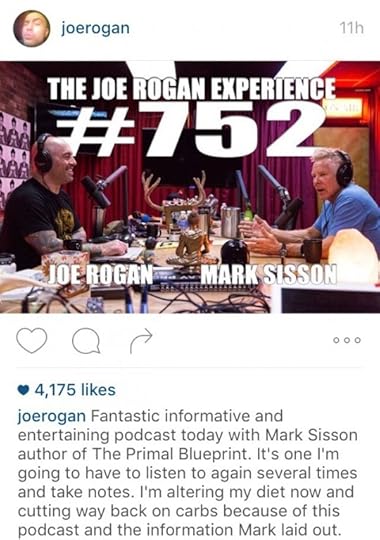
Comment of the Week
“Hey Dr. Oz, we booked Dr. Peter Attia to talk about the new outlook on saturated fats in the diet!”
“Great job team, he is a wealth of information on the topic. Let’s have him roll a bunch of balls down a stupid ramp to demonstrate the difference between small and large particle LDL! That’s a great use of our time with him!
Like This Blog Post? Subscribe to the Mark's Daily Apple Newsletter and Get 10 eBooks and More Delivered to Your Inbox for FREE
January 30, 2016
Duck Carnitas Tacos
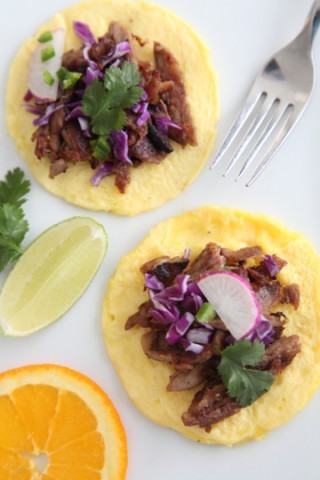 Mexican carnitas are made from meat that’s been slow-cooked in fat. Usually, this means pork braised in lard. But duck legs covered in a thick layer of fatty skin are ideal for this sort of cooking. Not only do you end up with easy, really delicious duck carnitas, you’ll have a little extra rendered duck fat in the pot to use for future cooking.
Mexican carnitas are made from meat that’s been slow-cooked in fat. Usually, this means pork braised in lard. But duck legs covered in a thick layer of fatty skin are ideal for this sort of cooking. Not only do you end up with easy, really delicious duck carnitas, you’ll have a little extra rendered duck fat in the pot to use for future cooking.
The tender, shredded duck meat is fried briefly to crisp up the edges, then it’s tossed with a cabbage slaw made from red cabbage, radishes, jalapeno peppers and cilantro. This combination of ingredients makes the slaw a brightly colored, sulfur rich, Vitamin C packed powerhouse…but you don’t have to think about that while you’re eating it. Just focus on how delicious the cool, crunchy, spicy slaw tastes with rich, crispy morsels of duck.
Servings: 4
Time in the Kitchen: 25 minutes hands-on, plus 2 hours to braise duck legs
Ingredients:
2 pounds duck legs (900g)
1 teaspoon five-spice powder (5 ml)
1 teaspoon plus 1/2 teaspoon salt, divided (5 ml plus 2.5 ml)
1 white or red onion, thinly sliced
4 garlic cloves, halved
1 orange, quartered
1/2 a small red cabbage, finely chopped
4 radishes, thinly sliced
1 cup loosely packed cilantro leaves (240 ml)
1 or 2 jalapenos, thinly sliced or chopped
1/4 cup lime juice (60 ml)
1/3 cup extra virgin olive oil (80 ml)
Instructions:
Heat oven to 350 °F/176 °C.
Season duck legs on both sides with five-spice powder and 1 teaspoon (5 ml) of the salt.
In a Dutch oven or lidded baking dish that snugly fits the duck legs, combine the duck legs, onion and garlic. Squeeze the orange wedges over the duck. Add the pieces of orange to the pot.
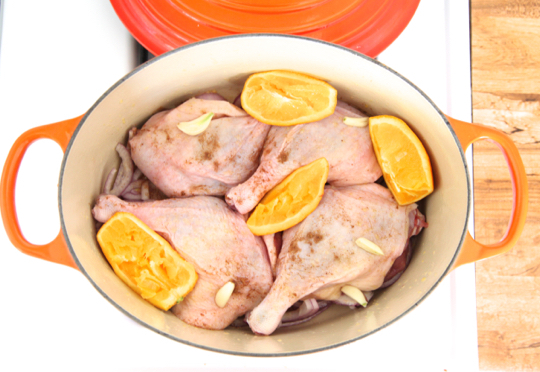
Cook covered until duck is very tender, which should take about 2 hours.
Let the duck cool then shred the duck meat off the bones.
While the duck is in the oven cooking, combine cabbage, radish, jalapeno, and cilantro in a medium bowl. Whisk together lime juice, olive oil and remaining ½ tsp (2.5 ml) salt and pour over cabbage mixture. Mix well. Refrigerate while the duck finishes cooking. Taste the slaw again before serving, and add more salt as needed.
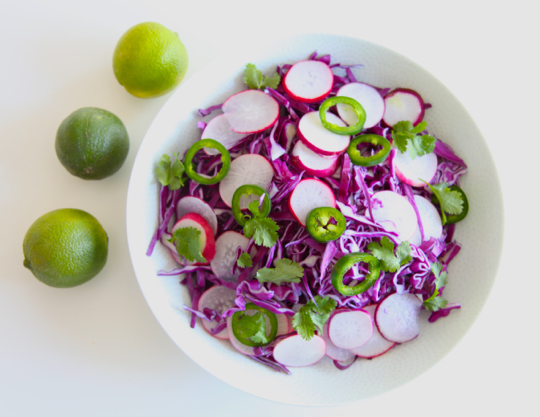
Heat a tablespoon of the rendered duck fat in a skillet over medium-high heat.
Add the shredded duck meat, cooking just a few minutes until crispy just around the edges. Don’t let the meat get too crispy, or it will be dry.
Serve the duck meat and slaw on Primal tortillas or on a thin omelet. Or, ditch the idea of a tortilla completely and serve these duck tacos in a bowl as a duck carnitas salad.
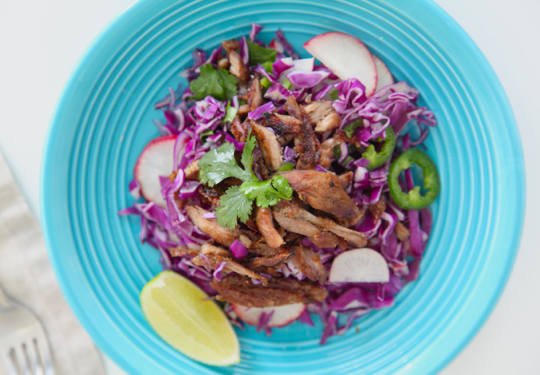

January 29, 2016
The Story of Primordial Stu: 180 Pounds of Weight Loss
It’s Friday, everyone! And that means another Primal Blueprint Real Life Story from a Mark’s Daily Apple reader. If you have your own success story and would like to share it with me and the Mark’s Daily Apple community please contact me here. I’ll continue to publish these each Friday as long as they keep coming in. Thank you for reading!
 This is a story of a fat man living to die…who is now dying to live.
This is a story of a fat man living to die…who is now dying to live.
I did not just wake up one day morbidly obese, on 17 prescription meds, a heart patient with three cardiac stents (having been “cathed” seven times with five angioplasties), and with type II diabetes, chronic migraines, hyperlipidemia, atherosclerosis, hypertension, sleep apnea, recurring bouts of kidney stones requiring hospitalization (due to medications), clinical depression, psoriatic arthritis/fibromyalgia (the doctors were split on that one), and PTSD…just for laughs.
I was always a “chunky” kid all throughout my school days. I was one of the kids that wore his Tuffskins tight, even in the new size “Husky.” “Big boned” was one of my favorite ways nice people would refer to me. There were plenty of others that were not so nice, but perhaps more accurate. I remember being 5 feet tall and 160 lbs in the 7th grade, and I was always either sick or had some physical injury, like ripped tendons and pulled muscles (no great wonder).
At 17 I enlisted in the United States Marine Corps. I was always in danger of being put into what they now call the “Body Composition Program,” although it was called by much less politically correct terms in my day. “Fat Boy Platoon” was one of the nicer labels. During Basic Training I got down to 167, and upon graduation of infantry training, I tipped the scales at 185 (I had added muscle to the leaner frame over the course of essentially six months of intense training…and I had just turned 18).
Shortly after my 23rd birthday, my active duty was up and I was honorably discharged into the USMC Individual Ready Reserves, and moved to New York City to seek my fortune (and starved). Two years later, my Military Service Obligation was up and I now weighed right around 200 lbs…despite (or perhaps because of) extremely poor nutrition. I was a bank teller by day, in retail at night and weekends, and selling some ghost writing. Not getting much sleep in the city that never sleeps.
I wandered into a mom and pop deli, and the help wanted sign was subsequently removed from the window. I learned to cook from scratch, old school, old world. I held a series of kitchen staff jobs for the next few years at trendy, but short-lived establishments (working for and learning from some amazingly talented, if bad tempered, Chefs), working my way up to Sous-chef. My weight was not an issue working in that environment, as the kitchens are hot, the pace is very fast, the hours are long and there was never a shortage of, shall we say, “recreational diet aids.”
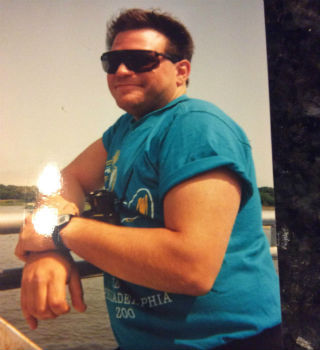 When I turned 29, I had had enough of New York City and decide to see what else was in this country, as I had already been to some “interesting” locations internationally courtesy of Uncle Sam. In my early 30’s I decided to return to the area that I grew up in for a visit, and decided—after meeting my future wife—to stay. My weight was steadily creeping up. A few years later I opened up a deli of my own, had a very successful small business, a wife and an infant son. I now weighed around 250 and was famous for the line, “Never trust a skinny chef.” During the holiday season of 2000, I was 37 years old and had a massive myocardial infarction. It was not my first helicopter ride in pain, and heavily sedated.
When I turned 29, I had had enough of New York City and decide to see what else was in this country, as I had already been to some “interesting” locations internationally courtesy of Uncle Sam. In my early 30’s I decided to return to the area that I grew up in for a visit, and decided—after meeting my future wife—to stay. My weight was steadily creeping up. A few years later I opened up a deli of my own, had a very successful small business, a wife and an infant son. I now weighed around 250 and was famous for the line, “Never trust a skinny chef.” During the holiday season of 2000, I was 37 years old and had a massive myocardial infarction. It was not my first helicopter ride in pain, and heavily sedated.
I did everything that the docs said to do: cardiac rehab, very low fat, no saturated fat or cholesterol, whole grains and all around 1800 to 2000 calories a day. I followed this religiously as the cardiologist told me, and when I asked him frankly about his prognosis, he responded, “If you don’t change your diet and lifestyle to what I recommend, I give you between 18 months to 3 years on the outside before you are dead.” So, follow his advice I did. We sold the deli and the attached house and moved to Amish-land, for a less stressful environment.
 All of my life I had suffered from acute migraines, and the frequency went from 3-4 times a year, to 3-4 times a week. I was feeling worse and getting more medicated by the year. My lipids were so high, at one point they were un-measurable. Shortly after, I was diagnosed as pre-diabetic and my cardiologist told me, “You might as well stop taking the medication I prescribed, if you aren’t going to follow the rest of my orders.” (I came very close to physically assaulting him…I WAS doing everything he told me to!) At this point I found a different cardiologist. I was now 38 and weighed 265 lbs. (I hadn’t gotten any taller.)
All of my life I had suffered from acute migraines, and the frequency went from 3-4 times a year, to 3-4 times a week. I was feeling worse and getting more medicated by the year. My lipids were so high, at one point they were un-measurable. Shortly after, I was diagnosed as pre-diabetic and my cardiologist told me, “You might as well stop taking the medication I prescribed, if you aren’t going to follow the rest of my orders.” (I came very close to physically assaulting him…I WAS doing everything he told me to!) At this point I found a different cardiologist. I was now 38 and weighed 265 lbs. (I hadn’t gotten any taller.)
I found a new cardiologist and so a new round of medications and rehab began. I tried Dr. Dean Ornish’s ultra low-animal-fat, plant-based diet…I gained 20 lbs in two months (and wasn’t terribly fond of the taste of paste anyway). I tried Atkins and lost 30 lbs before gaining it all back and then some. (Most likely on the “replacer” Atkins Brand products.) My weight was going up, not down. I was gaining 10-20 lbs a year on this wonderful low fat, low cholesterol, healthy whole grain, PUFA soaked, chemically laced diet.
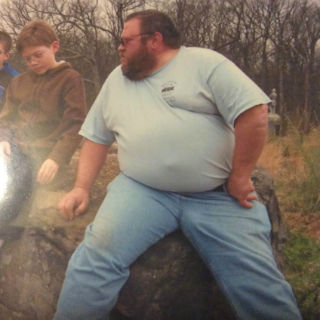 During the years between 2001-2010, I had six more catheterizations leading to angioplasties, or stents, for the crippling chronic chest pain I was getting often after physical activity or stress. By around 2006, I was up to 320 lbs and joined the YMCA. With two small boys in tow, I would work out for 4-5 hours a day. I managed to get back down to 250…but was really starting to feel worse and worse with constant joint pain, angina, migraines and the black lost netherworld of depression. I was working on the elliptical one day and got a very strong bout of chest pain…then I woke in a hospital bed after having my latest angioplasty and stent implant.
During the years between 2001-2010, I had six more catheterizations leading to angioplasties, or stents, for the crippling chronic chest pain I was getting often after physical activity or stress. By around 2006, I was up to 320 lbs and joined the YMCA. With two small boys in tow, I would work out for 4-5 hours a day. I managed to get back down to 250…but was really starting to feel worse and worse with constant joint pain, angina, migraines and the black lost netherworld of depression. I was working on the elliptical one day and got a very strong bout of chest pain…then I woke in a hospital bed after having my latest angioplasty and stent implant.
 I saw my cardiologist in the spring of 2014. I now weighed 357 lbs and had been full blown type II for three years. He had a “heart to heart” (no pun intended), frank discussion with me. “Stu, we’ve seen some improvements in the damage that the MI caused, but I’m doing and have done everything that I can for you. I’m afraid you most likely will not be there to see your sons graduate high school. Do you have an estate plan or trusts set up? I’m afraid you really need to get your affairs in order.” I asked “How long do I have?” and was smacked with the cold hand of reality with his followup response. “Two years, if we’re very lucky. Less if not.” (One thing I’ve always liked about this doc, he talks straight.) If people will tell you that a heart attack is a wake up call, then THIS was a four alarm fire siren.
I saw my cardiologist in the spring of 2014. I now weighed 357 lbs and had been full blown type II for three years. He had a “heart to heart” (no pun intended), frank discussion with me. “Stu, we’ve seen some improvements in the damage that the MI caused, but I’m doing and have done everything that I can for you. I’m afraid you most likely will not be there to see your sons graduate high school. Do you have an estate plan or trusts set up? I’m afraid you really need to get your affairs in order.” I asked “How long do I have?” and was smacked with the cold hand of reality with his followup response. “Two years, if we’re very lucky. Less if not.” (One thing I’ve always liked about this doc, he talks straight.) If people will tell you that a heart attack is a wake up call, then THIS was a four alarm fire siren.
I spent the next couple of days in a zombie like fugue. Curiously, a few nights before my visit, I had watched a TED Talk with Dr. Robert Lustig on the stellar qualities of sugar we typically consume, and had decided to eliminate HFCS and added sugar from my diet (which was in three quarters of the “heart healthy” products I was eating). At the end of two weeks, I had lost seven pounds. I was now an expert on all things “Lustig.” This led me to do a self experiment on food additives.
Having been in commercial kitchens for a dog’s age, I noticed that products were not the same as when I started cooking. It occurred to me that not only were there a lot more sugar and HFCS in ingredients that I would traditionally use, but they had a lot of things that didn’t sound like food. I was used to the “usual suspects” being a “no” (as a “no added salt,” cardiac kid), but, there’s only so much preserving that food needs. I tried eliminating “alien” additives as well. I lost 15 lbs the next two weeks and I hit the internet hard.
I was familiar with the organic movement and various lifestyles, from veganism to the macrobiotic crowd, from many years of food service. I had always looked on the Weston A. Price Foundation folks as amusing kookaboos that were all going to merrily drop dead of coronary disease, when I realized I was about to drop dead of coronary disease! I figured I quite literally had nothing to lose by going to a diet rich in organic saturated fat and protein, and very little “healthy” carbs.
One day, I found Mark’s Daily Apple. I was intrigued as I had just been researching Dr. Loren Cordain. I rushed out and bought a copy of The Primal Blueprint. I started following it, and was losing 7-10 lbs a WEEK! I was virtually melting before my family’s eyes. I had an incredible amount of energy, and my mood was improving. I decided it was time to stop taking most of the medications I was prescribed. (If I’d told him, THAT would have given my Cardiologist an MI of his very own!)
 I was down to 304 by June in this “before” photo and thought that I looked great! I did compared to where I was a few short months prior, when we were on a family vacation to Boston and the surrounding area. I was so proud of myself for being able to do the entire Freedom Trail. (A few years before we were there, I had to cut the vacation short after about 3/4 of a mile of trail…chest pains hospitalized me for one of my many angioplasties.)
I was down to 304 by June in this “before” photo and thought that I looked great! I did compared to where I was a few short months prior, when we were on a family vacation to Boston and the surrounding area. I was so proud of myself for being able to do the entire Freedom Trail. (A few years before we were there, I had to cut the vacation short after about 3/4 of a mile of trail…chest pains hospitalized me for one of my many angioplasties.)
I was following not only The Primal Blueprint, The Primal Connection, and Robb Wolf’s Paleo Solution, but was enrolled in The Primal Blueprint Expert Certification Program. It was now Thanksgiving of 2014, I weighed 210, my lipids were amazing, my a1c level was 4.1, migraines were down to 2-3 times a month, skin was clear for the first time in my life, and my joint pain was down 80%. My Cardiologist asked if I was back at the gym for daylong sessions, I told him what I was doing and he looked concerned and said “It can’t be that, it must be the meds.” I told him I hadn’t been taking most of them for four months, only the blood thinners, as I was concerned about all the vitamin K I was getting thickening my blood to the point of having a problem with the stents (that he had put in to save my life!). He looked at me in disbelief and clearly did not know what to do or say.
Then the chef in me decided I had to impress my family, friends and myself with all of the holiday goodies that I traditionally made…only primal versions now. And I ate them all. And made more. And ate them all.
I was close to completing my certification, and had gained 15 lbs back on a totally primal holiday binge! Oops!
In January 2015, I saw the Primal Blueprint 21 Day Challenge on Vimify. I signed up and successfully completed it. This was one of the best things I ever did in, and for, my life. The people were friendly and supportive, and the coaching was great. (Especially as there were thousands of folks to ride herd on.) This is how I was introduced to two of the nicest, most attentive and caring individuals with the largest knowledge and resource base in this lifestyle movement: Adam and Vanessa Lambert (both proteges of Mark Sisson AND Robb Wolf…check out their chops for yourself!). They were not only superb guest coaches for the Primal Blueprint 21-Day Challenge, but are the authors, shepherds and “Tribal Leaders” of BEE THE WELLNESS, and have gathered and cared for the finest group of individuals it has ever been my honor and privilege to be associated with.
At the conclusion of the “21 Day,” I was 198. Finally! Under 200!!! And I have been transforming a lot more of myself than just girth. I was 178 in the “after” photo. That was in June, near my 52nd birthday. Since then, my VA therapist cannot believe the change in my mental wellness. My sons are constantly amazed at the man that is their father (that they thought they knew), and my wife is famous for saying, “I’ve gotten my husband back!”
I saw my cardiologist a few months ago, and he sat me down for another “heart to heart” talk. This time he said “ Stu, I’ll be very surprised if you don’t live past 70 with the health you are in. If not for the MI damage, I would say 80’s.” Talk about good news…how about 20+ YEARS of LIFE being handed you!!
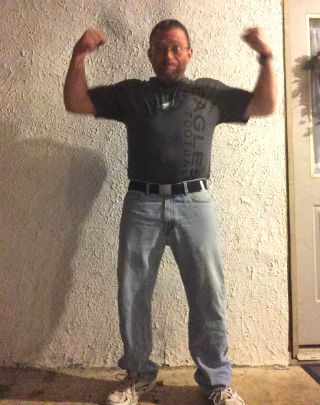 So to sum up this rather lengthy tale of transformation; I now weigh 175 lbs, I lost over 180 pounds (I LOST more than I weigh!), and my waist, formerly 56 inches is now 32 inches. My body fat percentage is somewhere around 15-18% (17% according to USMC tape standards…I was 20% 30 years ago!) My joint pain is totally reasonable for an active man in his 50’s. I no longer use a CPAP machine, or stop breathing while sleeping. My skin is clear (if still a tad large for me now). I have NO diabetes markers. My migraines are down to maybe once in 3-4 weeks, much more mild and not crippling (usually after I have poisoned myself with something SAD, by mistake…80/20 to the rescue!) No one thinks I am an alcoholic any longer (I’ve just plain lost all desire. It’s like I’ve forgotten to drink). My PTSD is better—still a struggle, but thankfully manageable. (This I credit to daily meditation and the camaraderie, support and goodwill of the “Tribe” at BTW!) I have energy, stamina and strength close to the “Kid Devil Dog, Two-Striper.” My blood pressure, heart rate and lipid panel are all amazing. (BETTER than in my youth in the Corps…Ooh Rah!) I’ve been given the GIFT OF LIFE! Thank you, Primal lifestyle, 21-Day Challenge, Primal Blueprint and Adam and Vanessa Lambert for outstanding coaching!
So to sum up this rather lengthy tale of transformation; I now weigh 175 lbs, I lost over 180 pounds (I LOST more than I weigh!), and my waist, formerly 56 inches is now 32 inches. My body fat percentage is somewhere around 15-18% (17% according to USMC tape standards…I was 20% 30 years ago!) My joint pain is totally reasonable for an active man in his 50’s. I no longer use a CPAP machine, or stop breathing while sleeping. My skin is clear (if still a tad large for me now). I have NO diabetes markers. My migraines are down to maybe once in 3-4 weeks, much more mild and not crippling (usually after I have poisoned myself with something SAD, by mistake…80/20 to the rescue!) No one thinks I am an alcoholic any longer (I’ve just plain lost all desire. It’s like I’ve forgotten to drink). My PTSD is better—still a struggle, but thankfully manageable. (This I credit to daily meditation and the camaraderie, support and goodwill of the “Tribe” at BTW!) I have energy, stamina and strength close to the “Kid Devil Dog, Two-Striper.” My blood pressure, heart rate and lipid panel are all amazing. (BETTER than in my youth in the Corps…Ooh Rah!) I’ve been given the GIFT OF LIFE! Thank you, Primal lifestyle, 21-Day Challenge, Primal Blueprint and Adam and Vanessa Lambert for outstanding coaching!
Full disclosure: I have had three chest pains in the past nice months (but not four or five in the same day as of old), and my wife says sometimes I occasionally softly snore!
If you have been on a fad diet roller coaster, or your weight or life is unmanageable, what have you got to lose? You’ve probably tried a whole boatload of things, right? What have you got to lose?
“Eat and Bee Well, Live Long, Love Strong, and Drop Dead Playing Happily.”
Primordial Stu
PS: Thank you, Mark Sisson, for the “Primal” books leading to my transformation, and for being a good sport about me shamelessly ripping off your motto and modifying it!
Like This Blog Post? Subscribe to the Mark's Daily Apple Newsletter and Get 10 eBooks and More Delivered to Your Inbox for FREE
January 28, 2016
Contest Results: What’s in Your Primal Kitchen?
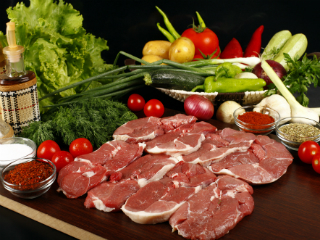 First, I have to say that I loved seeing all the pictures submitted for our “What’s in Your Primal Kitchen?” contest. It’s always a pleasure to see the happy, healthy, glowing faces of Mark’s Daily Apple readers—not to mention the great looking food sprawled across their kitchens! Once again, many thanks to everyone who participated.
First, I have to say that I loved seeing all the pictures submitted for our “What’s in Your Primal Kitchen?” contest. It’s always a pleasure to see the happy, healthy, glowing faces of Mark’s Daily Apple readers—not to mention the great looking food sprawled across their kitchens! Once again, many thanks to everyone who participated.
The lucky winner of this random drawing will take home The Holy Grail of PRIMAL KITCHEN™ Care Packages: 3 bottles of Avocado Oil, 6 jars of Avocado Oil Mayo, 2 bags of Primal Fuel, 2 bottles of Greek Vinaigrette, 2 bottles of Honey Mustard Vinaigrette, and 12 Dark Chocolate Almond Bars.
Are you the lucky winner?
First, before I announce who’s taking home that glorious prize, why don’t the rest of you take a look at the gallery of submissions? Each person below went through the fun of compiling their weekly menu all in one place for a stunning snapshot of primal goodness. Do you recognize some things you should be adding to your pantry? Or perhaps you recognize some things you already have in common? There’s nothing like seeing yourself through someone else’s eyes. But you haven’t lived honestly until you’ve seen yourself in someone else’s food—or something like that.
Now, without further delay, let me announce our winner…
Christian H.! Congratulations, my friend. Now you’ll have a whole host of extra grocery items to add to that pile of yours. I hope you have the room…

To track all the contests, visit the 2016 Primal Blueprint 21-Day Challenge Contest Page for daily updates.
Thanks for reading (and participating), everyone!




Mark Sisson's Blog
- Mark Sisson's profile
- 199 followers



